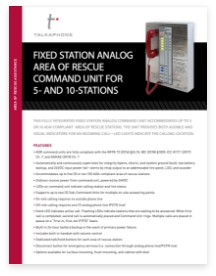Talkaphone’s Blue Light Phones provide much needed security to your school, town, business, and more, but only if they are kept up properly. In order to keep them running optimally, it is best to conduct a security system maintenance checkup every spring on the blue light phone system and hardware. Here are the most important things to look out for when going through these checks.
Get a helpful downloadable maintenance checklist by clicking here.
1. Physical Inspection
It starts with the basics. Make sure to check for any visible damage, including cracks, rust, missing screws, or indications of animal/insect infestation along with vandalism that may hinder the phone’s functions. It is also important that you check to ensure all of the signage is clear and legible and the LED blue light is operational. Signage/labeling on the Blue Light Phones instructs how to use the phone and is critical to maintenance. Signage also needs to be easy to read and denote the location where the blue light phones are located. Finally, you'll want to clean the exterior of the Blue Light Tower or Wall Mount and replace any faded, yellowed, or cracked polycarbonates. Cameras, lights, and speaker grills can get dirty quickly from being exposed to the elements, so it is beneficial to clean them as part of the security system maintenance to ensure that they are fully functional.
2. Power & Connectivity Check
The next step is to examine your Blue Light Phone’s connection. Start with confirming the strength of the connection, whether it is cellular, VolP, or a POTS line. If your Blue Light Phone currently has the POTS line, you may want to consider looking into the new VoLTE Retrofit Kit. The kit enables conversion of Blue Light Phones that are currently using POTS lines to 4G LTE cellular service, upgrading it to current communication standards. After verifying a working connection, be sure to inspect for any exposed or damaged wiring that needs attention–along with verification of the battery/solar array for performance and load while operating the phone and LED Blue Light.
3. Audio & Call Functionality
Now it is time to make sure the unit’s functions are up to par. Press the call button to test emergency response activation. Next, make sure that the audio transmission for both the incoming and outgoing communication has intelligibility. You will also want to verify that calls made from the Blue Light Phone are routed correctly to the designated security personnel so that there is a quick and accurate response time when faced with emergencies. During these test calls, it is critical to confirm with the operators that the system has presented or identified the physical location of the Blue Light Phones–especially with cellular services as the Caller ID can be presented as “wireless caller” rather than a location. This is an essential step of the security system maintenance process.
4. Lighting & Visibility
Next, make sure to test the LED Blue Light for proper function. The bright, continuously lit blue light attracts attention to the area and it is imperative that it immediately flashes after the call button is depressed. Also be sure that the area around the Blue Light Phone is well-lit and free of obstructions that might make it difficult for people to see or reach–anything that makes the Blue Light Phone inaccessible to those who may be using a wheelchair must be immediately removed.
5. Software & Integration
The supporting systems and integrations with the Blue Light Phone is just as important as its hardware. Make sure to confirm that the Blue Light Phone monitoring system is fully operational. These monitoring systems provide their own mini-checkups by regularly polling the phones and provide an alert when any are unreachable, so by checking your system, you are ensuring the functional state of your phone. Also, do not forget to review your logs for any missed alerts or unusual activity. If an audio call recorder is used, ensure that it is operational and that playback functions are accessible to operators/dispatchers.
6. Compliance, Documentation, Policies, and Procedures
Finally, it is essential that you know your phone is also up to standards on paper. Check to make sure your system meets ADA and safety compliance standards. You should also log the details, repairs, and maintenance needs present in the inspection for future reference. Finally, it is wise to train staff and/or responders on any new system updates so that they can also perform these checks and keep an eye out for any changes in the technology that may threaten safety.
Lastly, technology is only one aspect. Document policies and procedures on response–ensure documentation clearly identifies all locations for all blue light phones. Leverage cameras to confirm malicious activity and limit false reporting.
6. Testing of Ancillary Support Systems
Beyond core functions, consider testing other functions that may be equipped on or maybe used in conjunction with the Blue Light Phones–such systems include cameras, high-powered speaker array (big voice) systems, wireless access points, and information buttons (line routing and related).
If a comprehensive security maintenance checkup is beyond what your team can take on in addition to their daily responsibilities, consider hiring a third-party verification testing professional, like AEI Affiliated engineers.
“As with any security system, regular maintenance and testing of Blue Light Phones is paramount to ensuring they function properly when needed most,” said Sean Ahrens, CPP, CSC, FSyl, BSCP, CHPA, Security Market Group Leader at AEI Affiliated Engineers. “A well-maintained system not only provides a critical lifeline in emergencies but also instills confidence in students, employees, and the public that their safety is a priority.”
With the winter weather finally melting away and spring quickly approaching, it is an ideal time to check on your Blue Light Phones. Performing this security system maintenance procedure can mean the difference between whether or not your investment is ready for an emergency situation.












